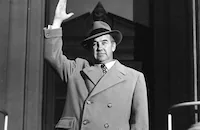The Castilian

Brief Synopsis
Cast & Crew
Javier Setó
Cesar Romero
Frankie Avalon
Broderick Crawford
Alida Valli
Spartaco Santoni
Film Details
Technical Specs

Synopsis
In 10th-century Spain Fernán Gonzáles, a Castilian nobleman, emerges from a self-imposed exile after the death of his older brother, the ruler of the city of Lara. Assisted by his loyal companion, Jerónimo, he leads a resistance army against the ruthless Navarrese troops and the Moors. After becoming enamored of the beautiful Sancha, the niece of Queen Teresa of León, Fernán kills Sancha's father, Don Sancho, the ruthless King of Navarre, who has attacked the Castilians in Valpierre. Fernán orders the dead of both sides to be buried together in the hope that this act will be accepted as a gesture of peace, but the late ruler's son and new king betrays Fernán and imprisons him in a dungeon. Aided by Sancha, he escapes and is reunited with Jerónimo to lead his small partisan force in a series of raids against the invading Moors. The vast Moorish army assembles under the command of Adberramán for an attack against the Castilians, but two patron saints of Spain, Millan and Santiago, come to earth in human form and counsel Fernán. Fortified by this divine intervention, the Castilians are able to rout the Moors. Following the victory the patron saints gallop into the sky, carrying with them the dead body of Jerónimo. The Castilians and the Navarrese come to a harmonious agreement, and Fernán and Sancha prepare for a peaceful rule over the grateful Castilian people.

Director
Javier Setó
Cast

Cesar Romero

Frankie Avalon

Broderick Crawford

Alida Valli
Spartaco Santoni
Teresa Velázquez

Fernando Rey
George Rigaud
Germán Cobos
Julio Peña
Angel Del Pozo

Linda Darnell
Hugo Pimentel
Beny Deus
Tomás Blanco
Rafael Durán
Roberto Rey
Francisco Morán
Crew
Luis De Los Arcos
José Buenagu
José Buenagu
Eric Chapman
Russell Faith
José Antonio De La Guerra
Michael Hamilburg
Joseph Leonard
Robert Marcucci
Richard C. Meyer
Richard C. Meyer
Margarita Ochoa
Mario Pacheco
Rafael Pacheco
Pérez Gómez
Sidney W. Pink
Sidney W. Pink
José Puyol
Paulino Rodrigo Díaz
Javier Setó
Al Wyatt
José Zamora

Film Details
Technical Specs

Articles
The Castilian
The cast of The Castilian is a polyglot group of actors from around the world. The best-known among them was Cuban/Italian-American Cesar Romero, who plays Fernan Gonzalez's mentor. The versatile Romero began his film career in the 1930s as a dancer and played villains and gangsters, then graduated to swashbucklers and Latin lovers. Romero is top-billed in the English-language version of The Castilian, and his dashing persona and distinctive voice are among pleasures in the film, amidst heavily dubbed performances by unfamiliar European actors. The Brooklyn-born Romero achieved cult status later in the 1960s as the villainous Joker in the Batman television series. Less comfortable in the period film is tough-guy Broderick Crawford, who looks and acts more like a Brooklyn gangster than a medieval monarch. He is credited as a "guest star," in a role that is little more than a cameo. Other guest stars are Spaniard Fernando Rey and Italian Alida Valli, in small roles as Spanish royals.
Singer Frankie Avalon is second-billed and opens the film as the minstrel Jerifan, who relates the story of Fernan Gonzales in song, and shows up periodically to move the story along. Avalon had been one of the top pop stars of the late 1950s, but with his smooth, mellow singing voice, he was more of a crooner in the Sinatra mold than just a teen idol. He also had a more varied and successful film career than his contemporaries, many of whom were one-hit wonders in both music and film. The same year Avalon appeared in The Castilian he also starred in the first of the "Beach Party" movies with fellow pop star Annette Funicello. Previously Avalon had supporting roles in the big-budget blockbuster The Alamo (1960) alongside John Wayne, and the sci-fi fantasy Voyage to the Bottom of the Sea (1961).
Playing Fernan Gonzalez is a Venezuelan-born actor who gets "Introducing" credit as "Spartaco Santony". As Espartaco Santoni, he became a successful star of action and horror films in Spain. Mexican actress Teresa Velazquez, who was often credited as "Tere Velazquez," was already a popular star of Mexican cinema when she appeared in The Castilian. She and Santoni met and fell in love while making the film. They married and had two children but eventually divorced. Spanish actress Soledad Miranda, who later became a cult star in the softcore porn/horror films of director Jess Franco, has a small role in The Castilian. A fatal car accident in 1970 cut short her career.
The Castilian was not a huge hit in the U.S., but did receive some respectable reviews. The New York Times critic was mildly enthusiastic: "Thanks mainly to an articulate script, full of historical footnotes, and the easy locomotion of a capable cast against some striking settings, this color picture has visual charm and genuine period flavor."
Director: Javier Seto
Producer: Sidney W. Pink
Screenplay: Paulino Rodrigo, Luis de los Arcos, Javier Seto, based on the epic poem
Cinematography: Mario Pacheco
Editor: Richard Mayer, Margarita de Ochoa
Costume Design: Jose Samora
Art Direction: Jose Antonio de la Guerra
Music: Jose Buenagu
Principal Cast: Cesar Romero (Jeronimo), Frankie Avalon (Jerifan), Spartaco Santony (Fernan Gonzalez), Teresa Velazquez (Sancha), Broderick Crawford (Don Sancho), Fernando Rey (King Ramiro of Leon), Alida Valli (Queen Teresa)
128 minutes
by Margarita Landazuri

The Castilian
Sidney Pink (1916-2002)
Born in Pittsburgh in 1916, Pink graduated from the University of Pittsburgh with a bachelor's degree in business administration. He began his film career as a projectionist in a theater owned by his wife's family. Moving to Hollywood in 1937, Pink was hired as production budget manager for Grand National Pictures, where he worked on the Tex Ritter musical western series. He later moved to Columbia and worked as a budget manager on Lost Horizon (1937) and many small scale westerns. After a disagreement with Columbia studio mogul Harry Cohn, Pink returned to the theater side of the business as the owner of a circuit of theaters in Los Angeles where he imported foreign films.
He soon hooked up with Arch Oboler for the production of two films, Five (1951), an offbeat feature about five survivors of a nuclear war and the irredeemably strange The Twonky (1953) about a professor (Hans Conreid) whose TV set becomes possessed by a spirit of the future and takes over his household.
Pink and Oboler would strike gold with their third film, the first full-length 3-D picture, Bwana Devil (1953). With television' popularity on the rise, a movie gimmick that advertised "A lion in your lap" or "A lover in your arms!" were promotional tag lines that came on like a carnival barker in a sideshow. The story about British railway workers in Kenya falling prey to two man-eating lions, and a head engineer (Robert Stack) bent on killing the lions before they feast on his entire crew might have been routine; but the movie, which required audience members to wear cardboard 3-D glasses as lions were jumping into your laps, spears were flying and people were coming toward you in hordes was a real hot ticket. The process, which was shot in Hollywood with two enormous cameras with polarized lenses, one for the left eye and one for the right, proved to be a surprising hit; enough so that Jack Warner came out with his own 3-D production at Warner Bros. with House of Wax (1953) starring Vincent Price and dozens of 3-D films followed in the ensuing decades.
After the success of his sci-fi cult hit The Angry Red Planet (1959), Pink found himself in a quandary. By the 1960s, Hollywood was having union problems, making it difficult for an independent producer like Sid Pink to be hired by the studios. Ever resourceful, he relocated to Denmark to produce and direct Reptilicus (1962 about a pre-historic monster that comes back to life and terrorizes Copenhagen! It may have not been high art, but it proved to be popular fare at drive-ins and its success allowed Pink to pursue film production in Europe throughout the remainder of the 1960s, including one of the earliest spaghetti westerns, Finger on the Trigger (1965) starring Rory Calhoun. Pink had one more fascinating footnote to fame when he discovered Dustin Hoffman in an off-Broadway production and cast him in Madigan's Millions (1967) as a U.S. Treasury agent sent to Italy to recover money that had been stolen by a murdered gangster (Cesar Romero). Pink soon retired from the film industry and eventually returned to the United States in the mid-1970s where he settled in Florida. He is survived by his wife, Marion, his son, Philip, a daughter, Helene Desloge and four grandchildren.
by Michael T. Toole
Sidney Pink (1916-2002)
Quotes
Trivia
Notes
Filmed in Spain; exteriors filmed in Burgos. Madrid opening: April 1963 as El valle de las espadas. May also be known in the United States under the working title Valley of the Swords.

Miscellaneous Notes
Released in United States Fall September 6, 1963
Film is based on a 13th Century Spanish epic poem "El poema de Fernan Gonzales."
Released in United States Fall September 6, 1963













